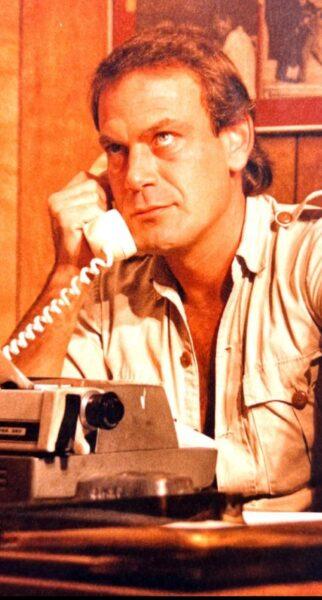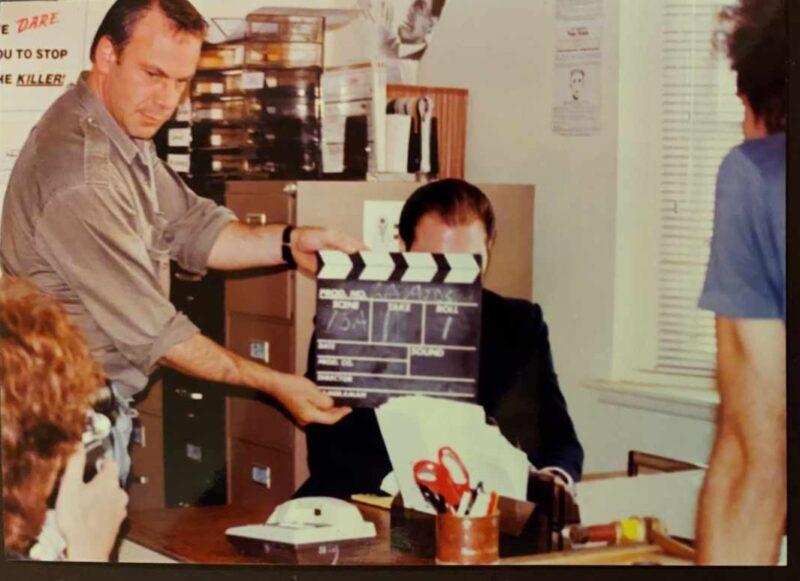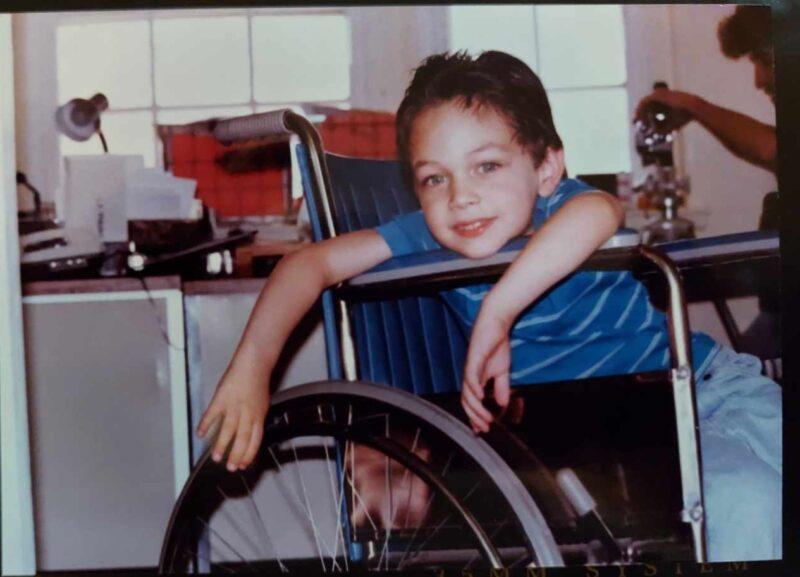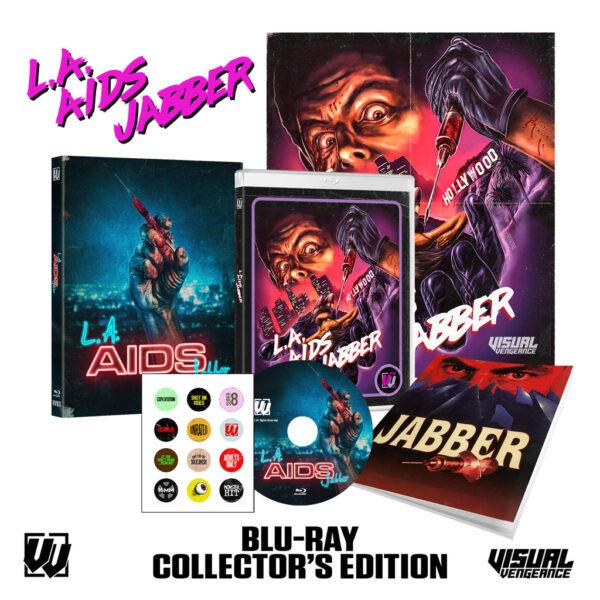With a name like LA AIDS Jabber, I’m surprised that this 1994 movie was not on my radar until recently. When I got the email offering an interview with the director, Drew Godderis, I had to say, “Yes!” Most people remember Drew as Uncle Anwar in the cult classic horror flick, Blood Diner, but what most people don’t know is that he also tried his hand at writing and directing. The result is an obscure, shot-on-video film that’s equal parts thriller and dark comedy. It’s about a young man diagnosed with AIDS who deals with his anger by running rampant through LA, sticking people with a needle full of his tainted blood. It’s both absurd and entertaining, and after watching the film, I immediately purchased the new pre-release.
It’s now almost 30 years later since Drew self-distributed his directorial debut, and it’s finally getting an audience. Thanks to Wild Eye Releasing and Visual Vengeance, LA AIDS Jabber is being released in a Holy Fuck edition, complete with stickers, poster, and enough special features to keep you busy for hours.
To celebrate this new release, I chatted with Drew via phone, where we went behind-the-scenes of LA AIDS Jabber.
Most photos are exclusive and provided by Drew himself.
**This interview contains SPOILERS**

PopHorror: LA AIDS Jabber is finally getting released with a ton of extras and special features, the first time since you self-distributed the film back in 1994. How does that feel?
Drew Godderis: It’s wonderful. It’s a credit to Rob Hauschild, who is the Visual Vengeance guy I believe, and Wild Eye for actually bringing it back. He was pretty observant to realize the correlation between AIDS and what’s going on now. I call AIDS the original OG pandemic, and what I did with this particular movie… Can I tell you the backstory, how it all kind of had its germination?
PopHorror: Yes, please!
Drew Godderis: Here’s what happened. I was doing a lot of acting in the mid to late ’80s. I started late in life at 32, and I started getting roles for these horror movies because, as a young guy starting out, those roles were available. I wasn’t having any trouble getting work. I was getting cast all over the place. I did it willingly and thankfully. What happened is I transitioned and started doing some television stuff like America’s Most Wanted and TV shows where I would work a week at a time. They call them character actors or day players. Long story short, my wife died in 88. She was 31, and we had a two-year-old boy.

PopHorror: Oh, my. I’m so sorry.
Drew Godderis: I had to obviously raise my son, and that was first and foremost important. I got out of the acting game, because I couldn’t travel anymore. I had nobody to really look after him, because we didn’t have any family close.
So, here’s what happened. I said to myself, “How can I continue to stay in this business, keep my foot in because maybe some time in the future I could go back when my son is grown?” I said, “I’ve been on enough movie sets. I love writing. Let me write a movie.” What I decided to do was, every day, I would go to a local place, and I would write a couple of scenes. Then I got a hold of a periodical that they had in Hollywood called The Drama-Logue where a lot of non-union actors would work. If you weren’t Screen Actors Guild—which I was—if you were a young guy starting out or somebody that wanted to work in a different kind of a movie, you might change your name or something, and you would look at this periodical. There would be roles in there. What happened was, I put an ad in there and got a number of actors. I auditioned them, picked the ones that I thought were good, and I made it clear that this was virtually a very, very low budget movie. And it was going to be a run and gun thing, meaning guerrilla shooting. We’d just be doing it quick and then getting out and moving on.

Based on that, I was able to find the actors, and I started out shooting on film. I had a 16mm film camera, and I was planning on using that 16mm print and blow it up to 35mm, which is a process. Then maybe I could distribute it in some small, arthouse theaters or something like that. But what happened is, the film camera broke down.
So, here I was with a broken-down film camera. I had a great cameraman from USC that was filming it. He wanted to do it on film obviously, because that was credit for his graduation from USC. So, he had to bow out. I had a choice. Fortunately for me, I was filming video at the same time I was using film as a cost saving measure, because I didn’t have a lot of money, and I was buying film. I was videoing the scene at the same time I was filming it on film. Then I could watch the video, and if it looked good, I knew that what I got on the camera was good, too. I could go on to the next scene.
But what happened is, I had a decision to make now. Do I quit filming with video, or do I continue on knowing that that limited where I could expose it, like home video stores or HBO. I went ahead and continued to film it on video, not really knowing how I was going to distribute it. Eventually, I was able to.
But just to backtrack a bit. When I was thinking about keeping my foot in the business and doing a movie, producing and directing, and so forth, I said to myself, “Well, what can I pick that would be controversial? That would get people’s attention and they would go, ‘What the…? What’s this? LA AIDS Jabber? What’s that?’” I decided that I wanted to do something that was current in the news. But I didn’t want to do anything that was disparaging towards people’s lifestyles, because as far as I’m concerned, people live their own lives, and everyone’s entitled to do what they want. I have no judgment in my heart.
And at that point in time, there were a lot of fingers being pointed towards the gay and lesbian community, and they were responsible for the AIDS epidemic. That was nothing but a crock of crap, because the bottom line was, people were getting it that were heterosexual, too. People were getting it that were having unprotected sex.
What I decided I was going to do was I be controversial by using another avenue… as a kid, under 20, picking it up through a blood transfusion. That was going on back then, too. If the blood hadn’t been tested, if they got AIDS-tainted blood, they would get it. I decided that was the route I wanted to go in, and so that was the storyline.
I was hoping that by being controversial enough and shooting on film, I could get a major studio to look at it and say, “You know what? Let’s blow this thing up to 35mm, and we’ll do a limited release on it.” Just because of the title and the shocking nature of it, it might get some legs, and then put me in a position to where I could do it full time again. But that obviously didn’t happen.
Anyway, here we are, and the movie’s made. Then I had it edited. Back then… Are you old enough to remember video stores?
PopHorror: Yes!
Drew Godderis: Okay. So you had to buy boxes. They had to make the VHS boxes and they were expensive. In order to get any kind of deal, you had to buy 1800 boxes at a buck a box. That was $1800.

PopHorror: Oh wow!
Drew Godderis: And then in order to run off VHS tapes at any kind of a deal, you had to 100 at a shot. I was pulling what hair I had left in my head out to see what I could to make this thing work. But I got it to a point where I could self-distribute it. It had a very limited run. There’s a brand new release now, but that’s because this is something that hasn’t really seen major distribution out there. So, what people are watching is a snapshot of that timeframe, late ’80s, early ’90s, when AIDS was prevalent in LA—obviously around the world, too—but in LA, it’s a snapshot of that time period with the funny mullet haircuts and the padded shoulders. A little less crazy LA. Have you ever been to LA?
PopHorror: Yes.
Drew Godderis: Well then, you know. So, that’s the deal with that.
This kid, Jason Majik, who was the star… I knew immediately once I saw him that he had something. I couldn’t quite put my finger on it, but I knew he could carry it, and he did. He was able to bring, as a young guy, these elements of strangeness, anger, losing it, and making this list. He could express all these emotions from within and really project them out. He did a marvelous job, as well as everyone else.
In the middle of the movie, there was this scene where we see a cop in the scene before… the partner of Detective Rogers, the female detective. And he’s gone, and the new guy appears. Do you remember that scene?
PopHorror: Yes.
Drew Godderis: Well, there’s an interesting story behind that, if you’re interested.
PopHorror: Yes, absolutely.

Drew Godderis: It was Tony Donangelo as the original detective. He had a great rapport with Marcy Lynn ,who played Detective Rogers. You can just tell the chemistry was there. They jived together very well. He had some scheduling conflicts. I had it where I had to get all the actors together to do scenes on a particular weekend on a particular time frame. Everyone had to work around stuff they had to do like going to jobs, shopping, and kids, or whatever. I had to be very specific about time and location, and when we were doing things.
And unfortunately, he couldn’t make a lot of these things, because he had other prior commitments and stuff. So, it got to the point where there were four or five of these hook-ups for scenes that we were going to shoot, and he couldn’t make it. So we had to say we were sorry, but it was just not working because I was concerned that I wouldn’t be able to continue shooting this thing.
At the suggestion of one of the cast members, we asked actor Justin Mack, who was perfect, and he came on board. Then I had to figure, “How am I going to work this out where we can transition this guy in?” Then I thought maybe the other guy was killed by a drunk driver, so the captain, along with this new detective, wake up Detective Rogers at three in the morning and introduce her to the new guy. It seemed to work okay. It’s an interesting kind of transition there.
PopHorror: I have to ask you: how did you land on the title of LA AIDS Jabber?
Drew Godderis: Originally, it was released under the name Jabber.
PopHorror: Yes, I did see that.
Drew Godderis: I was so concerned about being correct. I didn’t want to offend anybody, and I thought by using the word “AIDS” in there, I thought it might drive sales away if I was going to sell to video stores. “AIDS? What are you talking about? Are you crazy?”
So, I made two titles. I made LA AIDS Jabber, and I made Jabber, and I released it under the name Jabber. Although I think there were a number of original VHS copies that still said LA AIDS Jabber. So that’s kind of an interesting thing.
How I decided on the name is this. It was LA, and AIDS was prominent. The original box art was actually me—because I couldn’t really find anyone else to do it—my eyes over glass. You see the cityscape behind it, and a big needle flying through the air. It was something I was hoping would capture attention, and it did. Video stores—the ones that I got it to—really liked it.
So, that’s where that name had its origins. But from the standpoint of I can’t lie and be dishonest, I was trying to figure out something in a kind of exploitative type of way to get people to notice it, but in the same token, I did not want to offend somebody. So, I was extra careful to make it a situation where anybody could pick up AIDS.

PopHorror: I have to say that the title, LA AIDS Jabber, is what drew my attention to it. People are just going crazy with this online. I have friends, myself included, that have purchased the pre-order. Are you surprised by the anticipation and excitement for this release?
Drew Godderis: I can say I thank God and whoever else out there in the universe that is helping me. I am clearly and unabashedly 100% thankful, because I didn’t think this had any legs 30 years later.
Funny story about how it happened. That promo I was telling you about on YouTube for Blood Diner was still up there. The producer of that segment came out from the East Coast and interviewed me in Prescott, Arizona. I drove up from Nogales to this old hotel. I don’t remember what the name is, but it’s one of those boutique hotels. She interviewed me in the lobby there. She knew the guy at Wild Eye Releasing, or she knew somebody that knew him.
She’d asked me what my history was. What did I do? I said that I was an actor originally, and then I produced a movie, but it had a very short release. I told her, and somehow that knowledge got back to Rob Hauschild, who called me and said, “Hey, I understand you have this thing. It had a very limited release. Now all these kids want to see this shot-on-video rough around the edges kind of crazy stuff going on. Do you happen to have it?” I said, “I do. It’s collecting dust on my shelf.” He said, “Do you want to put it out again?” and I said, “Sure. Put it out under the name Jabber?” And Rob said, “No. Let’s use LA AIDS Jabber.” I said, “Are you sure?” And he said, “Absolutely. That’s going to be the real draw.”
It’s no Academy Award winner. It is what it is, a locked-in time look at what LA was like and AIDS back then. It was one of these things where people wouldn’t even get close to other people. There were people that were under the impression that if you just get close to somebody, you’re going to get AIDS. They didn’t even realize that that is not how it’s transmitted. Thank God we have that under control now, and there’s a cocktail. But back then, it wasn’t. And that’s why it’s an interesting story.
***SPOILER***
Of course, we find out at the end that he doesn’t have anything at all, that it was a misdiagnosis by the lab. We took a lot of chances with that movie. We were shooting on the streets with guns. They weren’t loaded, but they were real guns, and we were running up and down the street. If we had been caught… oh, boy. You might not be talking to me now.

PopHorror: You said you shot it guerrilla style, right?
Drew Godderis: Yeah! This was all run and gun. The editor on this was a professional. He did a lot of movies and TV shows, but he didn’t want to be associated with the movie, because it was non-union, and he was union. If he got caught editing something that was non-union, he could have had some real trouble. So, he changed his name. He also composed the music and edited it. He did all of that for like $600. It was a hell of a deal.
PopHorror: I noticed the name Justin Godderis in the credits and on IMDb. Is that your son?
Drew Godderis: That’s a story. I’ll tell you about that. Thank you for reminding me about that. Justin’s mother died in 88. I think we shot it in 91, so he would have been three, three and half. He never knew his mother, because she died before he really knew her. All he’s got are some pictures and video stuff. Marcy Lynn bonded with him, because he really didn’t have any female influences. She became “Mama.” If you’re a producer with no money, you do whatever you need to do, including using your kids in something. I thought, “Wouldn’t it be great to give her a little bit of a family life?”
PopHorror: Was the child playing her son?
Drew Godderis: Yeah. He remembered the lines like crazy, and did a great job. To get him to talk about it now, he just rolls his eyes.

PopHorror: I tried researching it online, but I couldn’t find anything. I didn’t realize he was so young at the time.
Drew Godderis: He’s mid-30s now. He’s up in Canada.
Listen, while I was making that film, let me tell you what I was doing with my living situation. I lost my home, because I didn’t have the money to keep up with the mortgage payment when I stopped acting. I moved into a real low-cost weekly motel in Los Angeles, and he was with me there. I took a night job, and I was able to bring him to work with me and have him sleep there. This was before he went to school.
From there, I moved into an old office building in downtown Los Angeles. I rented an office, and I got one of these loveseat convertible bed things, a little mini refrigerator, and a little hot plate. We would go in there at night and sleep. He was about four years old, so he didn’t know any different. The security guard knew that we were in there and that we were staying in that place, and he never said a word.
PopHorror: Oh, wow.
Drew Godderis: He would see me coming in through the front door of the building, he would just look the other way. Or if he did see me, he would smile and wave, and that was it. Thank God I had all these nice elements to help me get through it. I had a really hard, tough time.
There were times when I didn’t think I was going to be able to make it. But you know what? Little did I know, Tiffany. Here we are, 30 years later. That YouTube video still being up there, this guy with the releasing company seeing that, the fact that I had it. It was sitting on the shelf for 30 years, and now there’s a pandemic. That’s like synchronicity. It’s more than coincidence.
PopHorror: Absolutely! Look where you are now. Who would have known when you were self-distributing back in 94 that now you’d be getting this deluxe release?
Drew Godderis: Exactly! You are absolutely right. It’s like sometimes you give up hope. I just tell people this will be great because this will help pay for my assisted living. When people are getting this, it’s a fresh piece. So, that’s kind of cool. We’re hoping for some real success with this, so we’ll see. I think it will probably do well. I think it’ll have some legs. The thing I’m going to advise to the young filmmakers that see this is that if I could pull this off back then, when there were no venues to release… HBO never would have released a title like this.
PopHorror: No.
Drew Godderis: Never in a million years. I had one option… to sell at video stores. And fortunately, I was able to do some of that.
PopHorror: I just have one last question for you today. What is your favorite scary movie?
Drew Godderis: What is my favorite scary movie? That is an interesting question. I don’t watch a lot of movies. Isn’t that strange? I think, to be honest with you, I’m going to say Blood Diner.

Thank you so much, Drew, for taking the time to speak with us. LA AIDS Jabber is now available for pre-order and will be released on August 9, 2022.
 PopHorror Let's Get Scared
PopHorror Let's Get Scared




